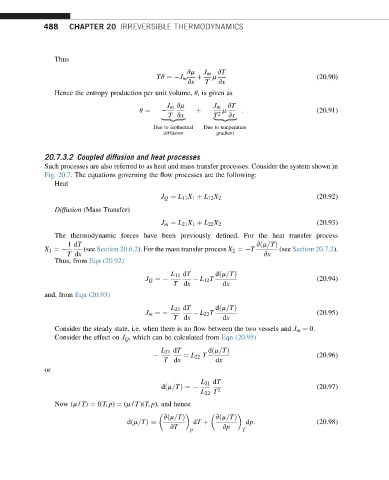Page 496 - Advanced thermodynamics for engineers
P. 496
488 CHAPTER 20 IRREVERSIBLE THERMODYNAMICS
Thus
vm J m vT
Tq ¼ J m þ m (20.90)
vx T vx
Hence the entropy production per unit volume, q, is given as
J m vm J m vT
q ¼ þ 2 m : (20.91)
T vx T vx
|fflfflfflffl{zfflfflfflffl} |fflfflfflffl{zfflfflfflffl}
Due to isothermal Due to temperature
diffusion gradient
20.7.3.2 Coupled diffusion and heat processes
Such processes are also referred to as heat and mass transfer processes. Consider the system shown in
Fig. 20.7. The equations governing the flow processes are the following:
Heat
J Q ¼ L 11 X 1 þ L 12 X 2 (20.92)
Diffusion (Mass Transfer)
J m ¼ L 21 X 1 þ L 22 X 2 (20.93)
The thermodynamic forces have been previously defined. For the heat transfer process
1 dT vðm=TÞ
X 1 ¼ (see Section 20.6.2). For the mass transfer process X 2 ¼ T (see Section 20.7.2).
T dx vx
Thus, from Eqn (20.92)
L 11 dT dðm=TÞ
J Q ¼ L 12 T (20.94)
T dx dx
and, from Eqn (20.93)
L 21 dT dðm=TÞ
J m ¼ L 22 T (20.95)
T dx dx
Consider the steady state, i.e. when there is no flow between the two vessels and J m ¼ 0.
Consider the effect on J Q , which can be calculated from Eqn (20.95)
L 21 dT dðm=TÞ
¼ L 22 T (20.96)
T dx dx
or
L 21 dT
dðm=TÞ¼ (20.97)
L 22 T 2
Now (m / T) ¼ f(T, p) ¼ (m / T)(T, p), and hence
vðm=TÞ vðm=TÞ
dðm=TÞ¼ dT þ dp: (20.98)
vT vp
p T

